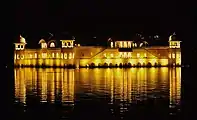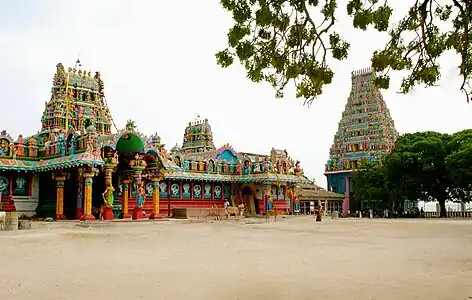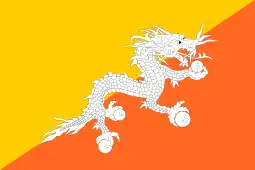 | |
 | |
| Total population | |
|---|---|
| c. 1.20 billion
(61.1% of the total South Asian population)[lower-alpha 1] | |
| Regions with significant populations | |
| 1,148,930,682 (2022)[1][lower-alpha 2][8][9][10][11] | |
| 24,931,944 (2022)[2][lower-alpha 3][12] | |
| 13,130,109 (2022)[13][3][14][15] | |
| 5,198,570 (2022)[4][lower-alpha 4][17][18] | |
| 2,921,627 (2022)[5][lower-alpha 5][19][20] | |
| 191,778 (2022)[6][lower-alpha 6] | |
| 50 (2021)[21] | |
| Religions | |
| Hinduism Tribal religions (including Sarnaism, Nanakpanthi, Kalasha and others) (minority) | |
| Scriptures | |
| Bhagavad Gita and Vedas also see other Hindu texts | |
| Languages | |
| Predominant spoken language Hindi Recognized regional languages Sacred language Sanskrit (Sacred) and Old Tamil[22] | |
Hinduism is the largest religion in South Asia with about 1.2 billion Hindus, forming just under two-thirds of South Asia's population.[lower-alpha 1][lower-alpha 2][lower-alpha 3][lower-alpha 4][lower-alpha 5][lower-alpha 6][23] South Asia has the largest population of Hindus in the world, with about 99% of all global Hindus being from South Asia.[24] Hinduism is the dominant religion in India and Nepal and is the second-largest religion in Bangladesh, Pakistan, Sri Lanka, and Bhutan.[25]
Indo-Aryan migrations brought the Indo-Aryans to South Asia,[26] where they compiled and composed the Vedic corpus during the Vedic period (ca. 1500-500 BCE) across present-day Northern India, Pakistan and Afghanistan.[27] The subsequent period, between 800 BCE and 250 BCE, was "a turning point between the Vedic religion and Hindu religions", and a formative period for Hinduism, Jainism and Buddhism. The Epic and Early Puranic period, from c. 250 BCE and 500 CE, saw the onset of the Hindu synthesis, followed by the classical "Golden Age" of India (c. 350 - 650 CE), which coincides with the Gupta Empire. [28]
Following the conquest of Islamic rulers in the Indian subcontinent and spread of Islam in South Asia, an era featuring persecution of Hindus began and continued until the end of Mughal Empire.[upper-alpha 1] The Vijayanagara and Maratha Empire significantly protected and revived Hinduism in the Indian subcontinent, while the Jaffna Kingdom and Gorkha dynasty have significantly protected Hinduism in Sri Lanka and Nepal respectively.[28]
History
Origins
The Vedic period, named after the Vedic religion of the Indo-Aryans, lasted from c. 1900 BCE-500 BCE. The Indo-Aryans were pastoralists who migrated into north-western India after the collapse of the Indus Valley Civilization. Linguistic and archaeological data show a cultural change in the subcontinent after 1500 BCE, with the linguistic and religious data clearly showing links with Indo-European languages and religion. By about 1500 BCE, the Vedic culture and agrarian lifestyle were established in the northwest and northern Gangetic plain of South Asia. Rudimentary state-forms appeared, of which the Kuru-Pañcāla union was the most influential. The first recorded state-level society in South Asia existed around 1000 BCE. In this period, states Samuel emerged the Brahmana and Aranyaka layers of Vedic texts, which merged into the earliest Upanishads. These texts began to ask the meaning of a ritual, adding increasing levels of philosophical and metaphysical speculation, or "Hindu synthesis".
Rise of Hindu Nationalism
In recent years, there has been a rising movement of Hindu nationalism and feeling of Hindutva or Hindu identity among the Hindus of India.[30] This has been observed especially after the formation of the BJP government in India in 2014.[31] In India, several Hindu nationalist political parties exist, out of which the BJP is the biggest among them.[32] Alongside the BJP, the Rashtriya Swayamsevak Sangh (RSS) has also been accused of being a chief organisation in the Hindu nationalist cause.[33][34]
The rise of Hindu nationalism and Hindutva is seen as a threat to the secular laws of India.[35] It was also seen that the with rise of the Hindu nationalism, there has been an increase in persecutions of religious minorities, mainly Muslims and Christians.[36][37] The government of Narendra Modi has also been blamed for the increase in violence.[38] Other hardline Hindutva groups, such as the Vishva Hindu Parishad (VHP)[39] and the Bajrang Dal[40] (which are designated as paramilitary groups by many nations such as Australia,[41] Canada and United States[42]) have also contributed a major role to the enhancement of Hindu nationalism and are also blamed for increasing Islamophobia in India and attacks on Christians.[43][44]
Similarly, Nepal has also experienced the same rise in Hindu nationalism, mainly after 2015 after demonstrators protested for the re-declaration of Hinduism as the state religion of Nepal along with the restoration of the monarchy in the country. Nepal has seen an increase in violence against Christians.[45]
Temples

.jpg.webp) Vishvanatha Temple, part of the Khajuraho group of monuments.
Vishvanatha Temple, part of the Khajuraho group of monuments.
 The rock-cut Shore Temple of the temples in Mahabalipuram, Tamil Nadu, 700–728.
The rock-cut Shore Temple of the temples in Mahabalipuram, Tamil Nadu, 700–728.
.jpg.webp)
 Front entrance of Nainativu Nagapooshani Amman temple.
Front entrance of Nainativu Nagapooshani Amman temple.
Organisations
Most Hindu organisations in South Asia are based in India and Nepal, although there are other organizations based elsewhere in South Asia.
Political
Social
- Banga Sena (
 )
) - Hindu Dharma Samudaya (
 )
) - Siva Senai (
 )
) - Hindu Prajatantrik Party (
 )
)
Demographics
Hinduism is the majority religion in South Asia, and most of the world's Hindus are home to the region.[46] 5 of the 10 nations with the biggest Hindu populations are in South Asia, namely India, Nepal, Bangladesh, Pakistan and Sri Lanka. India is home to more than 1.2 billion Hindus, 94% of the world's global Hindu population.[47][48]
Hinduism is the majority religion in Nepal and India, with 81.34% and 79.8% of the countries' respective populations practicing Hinduism.[upper-alpha 2] Hinduism is the second largest religious group in Bangladesh, Pakistan, Sri Lanka and Bhutan and there is a very minute Hindu minority in Afghanistan.[21] There are also no Hindus in the Maldives, as per its constitution.[upper-alpha 3]
In recent years, Hindu populations have decreased in non-Hindu majority countries in South Asia, especially Sri Lanka, Afghanistan, Bangladesh and Pakistan. This is due to a number of reasons, such as persecution, forced conversion and low-fertility rates.[50][51] Civil war in Afghanistan and Sri Lanka have also caused Hindus to flee these countries.[52][53]
See also
Notes
- ↑ "The Mohammedan conquest of India is probably the bloodiest story in history. It is a discouraging tale, for its evident moral is that civilization is a precarious thing, whose delicate complex of order and liberty, culture and peace may at any time be overthrown by barbarians invading from without or multiplying within. The Hindus had allowed their strength to be wasted in internal division and war; they had adopted religions like Buddhism and Jainism, which unnerved them for the tasks of life; they had failed to organize their forces for the protection of their frontiers and their capitals."[29]
- ↑ Nepal and India are the only sovereign nations in the world that have Hindus as a majority population, where in Nepal Hindus accounts for nearly 81% and India with nearly 79.8%.
- ↑ Sunni Islam is the state religion of the Maldives and as per the 2008 Constitution, only Sunni Muslims are capable of holding Maldivian citizenship and the government mandates that all citizens practice Sunni Islam, effectively making its population 100% Muslim.[49]
- 1 2 2022 national population estimates by the World Factbook result in a South Asian population of 1,891,670,539.[1][2][3][4][5][6][7]
- 1 2 Hindus comprise 79.8% (1,148,930,682) of India's total population of 1,389,637,446 per 2022 estimate by the World Factbook.[1]
- 1 2 Hindus comprise 81.3% (24,931,944) of Nepal's total population of 30,666,598 per 2022 estimate by the World Factbook.[2]
- 1 2 Hindus comprise 2.14% (5,198,570) of Pakistan's total population of 242,923,845. Hindu percentage is derived from the 2017 Pakistan Census while the total population is a 2022 estimate by the World Factbook.[4][16]
- 1 2 Hindus comprise 12.6% (2,921,627) of Sri Lanka's total population of 23,187,516 per 2022 estimate by the World Factbook.[5]
- 1 2 Hindus comprise 22.1% (191,778) of Bhutan's total population of 867,775 per 2022 estimate by the World Factbook.[6]
References
Citations
- 1 2 3 "India People and Society". The World Factbook. Retrieved 3 August 2022.
- 1 2 3 "Nepal People and Society". The World Factbook. Retrieved 3 August 2022.
- 1 2 "Bangladesh People and Society". The World Factbook. Retrieved 3 August 2022.
- 1 2 3 "Pakistan People and Society". The World Factbook. Retrieved 3 August 2022.
- 1 2 3 "Sri Lanka People and Society". The World Factbook. Retrieved 3 August 2022.
- 1 2 3 "Bhutan People and Society". The World Factbook. Retrieved 3 August 2022.
- ↑ "Afghanistan People and Society". The World Factbook. Retrieved 3 August 2022.
- ↑ "Can Muslims surpass Hindus in population numbers? Experts say practically not possible". 24 April 2022.
- ↑ "The Future of World Religions: Population Growth Projections, 2010–2050". Pew Research Center. 1 January 2020. Archived from the original on 22 February 2017. Retrieved 22 February 2017.
- ↑ "Központi Statisztikai Hivatal". Nepszamlalas.hu. Retrieved 2 October 2013.
- ↑ "India's religions by numbers". The Hindu. 26 August 2015 – via www.thehindu.com.
- ↑ "Nepal". US Department of State.
- ↑ "Census 2022: Bangladesh population now 165 million". 27 July 2022.
- ↑ "Atrocities on Hindus in Bangladesh: Now, 1.8 crore Hindu Bengali citizens of Bangladesh are ready to go to India, said Ravindra Ghosh, Chairman of Bangladesh Hindu Janajagruti Samiti". Retrieved 9 May 2021.
- ↑ "Hindu population in Bangladesh grew by 1 per cent in 2015: Report". The Economic Times. 23 June 2016. Retrieved 16 June 2021.
- ↑ "SALIENT FEATURES OF FINAL RESULTS CENSUS-2017" (PDF). Retrieved 3 August 2022.
- ↑ "Hindus under the official Muslims of Pakistan". 17 July 2020.
- ↑ "Religion wise population, Pakistan". Government of Pakistan. Archived from the original on 19 July 2014.
- ↑ "A3 : Population by religion according to districts, 2012". Census of Population & Housing, 2011. Department of Census & Statistics, Sri Lanka.
- ↑ "Census of Population and Housing 2011". Department of Census and Statistic. Retrieved 13 October 2019.
- 1 2 Country Policy and Information Note: Afghanistan: Hindus and Sikhs (PDF). Home Office, United Kingdom (Report). 6.0. March 2021. p. 15. Retrieved 17 May 2021.
- ↑ Johnson, Todd M.; Grim, Brian J. (2013). The World's Religions in Figures: An Introduction to International Religious Demography (PDF). Hoboken, NJ: Wiley-Blackwell. p. 10. Archived from the original (PDF) on 20 October 2013. Retrieved 24 November 2015.
- ↑ "Region: Asia-Pacific". Pew Research Center's Religion & Public Life Project. 27 January 2011. Retrieved 16 June 2021.
- ↑ Pechilis, Karen; Raj, Selva J. (2013). South Asian Religions: Tradition and Today. Routledge. ISBN 978-0-415-44851-2.
- ↑ "Hindus". Pew Research Center's Religion & Public Life Project. 18 December 2012. Retrieved 16 June 2021.
- ↑ Flood 1996, pp. 21–23.
- ↑ Thapar 1966, p. 23.
- 1 2 Honour & Fleming 2005, p. 123-141.
- ↑ Durant 1976, pp. 458–472.
- ↑ "The Rise of Hindu Nationalism and Its Regional and Global Ramifications". Association for Asian Studies. Retrieved 9 April 2021.
- ↑ Hindu nationalism 2019h.
- ↑ Kumar, Ashutosh (13 May 2020), "Hindu nationalism in india: a historical perspective", Great Transition in India, WORLD SCIENTIFIC, pp. 123–141, doi:10.1142/9789811222344_0006, ISBN 978-981-12-2233-7, S2CID 225367347, retrieved 9 April 2021
- ↑ Chandra, Bipan (2008). Communalism in Modern India. Har-Anand. p. 140. ISBN 978-81-241-1416-2.
- ↑ "The Powerful Group Shaping The Rise Of Hindu Nationalism In India". NPR. Retrieved 9 April 2021.
- ↑ Anand, Dibyesh (2011). "Hindu Nationalism in India". Hindu Nationalism in India and the Politics of Fear: 1–17. doi:10.1057/9780230339545_1. ISBN 978-1-349-37190-7.
- ↑ "Attacks on Muslims and Christians Continue to Rise in India". Religion Unplugged. Retrieved 9 April 2021.
- ↑ "Muslims and Christians will be wiped out of India by December 31, 2021: BJP leader Rajeshwar Singh". SabrangIndia. 14 December 2014. Retrieved 9 April 2021.
- ↑ Wallen, Joe (16 February 2020). "Narendra Modi's Hindu nationalism gives rise to vigilante attacks on Christians". The Telegraph. ISSN 0307-1235. Retrieved 9 April 2021.
- ↑ Khosla, Madhav (3 June 2019). "Indian history tells us that to move beyond Hindu nationalism, we must move beyond identity". ThePrint. Retrieved 9 April 2021.
- ↑ Pathak, Vikas (12 December 2015). "The musclemen of Hindutva". The Hindu. ISSN 0971-751X. Retrieved 9 April 2021.
- ↑ "Australian Senator demands ban on RSS, VHP". Kashmir Media Service. 8 March 2021. Retrieved 9 April 2021.
- ↑ "Hindu Nationalist Groups Are Expanding In East Asia". Religion Unplugged. Retrieved 9 April 2021.
- ↑ Anand, Dibyesh (1 April 2005). "The Violence of Security: Hindu Nationalism and the Politics of Representing 'the Muslim' as a Danger". The Round Table. 94 (379): 203–215. doi:10.1080/00358530500099076. ISSN 0035-8533. S2CID 144557681.
- ↑ "Hindutva: The Growth of Violent Hindu Nationalism". www.outlookindia. Retrieved 9 April 2021.
- ↑ "India's Hindu nationalists spy a chance to boost Nepal royalists". South China Morning Post. 19 January 2021. Retrieved 16 June 2021.
- ↑ "Countries with the largest Hindu population in 2010". Statista. Retrieved 10 August 2021.
- ↑ "Census 2011: Hindus dip to below 80 per cent of population; Muslim share up, slows down". The Indian Express. 27 August 2015. Retrieved 16 June 2021.
- ↑ "Hindu Countries 2021". worldpopulationreview.com. Retrieved 10 August 2021.
- ↑ "2008 Constitution of Maldives". Government of Maldives.
- ↑ "India needs to find a sane way to discuss relative decline in Hindu population". Economic Times Blog. 23 April 2015. Retrieved 10 August 2021.
- ↑ Eaton 1993, p. 89.
- ↑ "Sri Lanka Census by Religion from 1881 to 2001". www.worldgenweb.org. Retrieved 10 August 2021.
- ↑ "Sikhs and Hindus of Afghanistan — how many remain, why they want to leave". The Indian Express. 28 July 2020. Retrieved 10 August 2021.
Sources
- Thapar, Romila (1966). A History of India. Penguin Books. ISBN 978-0140138351.
- Michaels, Axel (2004). Hinduism. Past and present. Princeton, New Jersey: Princeton University Press. ISBN 978-0691089539.
- Doniger, Wendy (2010). The Hindus: An Alternative History. Oxford University Press. ISBN 978-0-19-959334-7.
- Flood, Gavin D. (1996). An Introduction to Hinduism. Cambridge University Press.
- Michell, George (1977). The Hindu Temple: An Introduction to Its Meaning and Forms. University of Chicago Press. ISBN 978-0-226-53230-1.
- Avari, Burjor (2013). Islamic Civilization in South Asia: A history of Muslim power and presence in the Indian subcontinent. Routledge. ISBN 978-0-415-58061-8.
- Doniger, Wendy (1999). Merriam-Webster's Encyclopedia of World Religions. Merriam-Webster. ISBN 978-0-87779-044-0.
- Eaton, Richard M. (1993). The Rise of Islam and the Bengal Frontier, 1204–1760. University of California Press.
- Eaton, Richard M. (2006). "Introduction". In Chatterjee, Indrani; Eaton, Richard M. (eds.). Slavery and South Asian History. Indiana University Press 0-2533. ISBN 978-0-253-34810-4.
- Durant, Will (1976). The Story of Civilization: Our Oriental Heritage. Simon & Schuster. p. 459. ISBN 978-0671548001.
- Paul, Pran Gopal; Paul, Debjani (1989). "Brahmanical Imagery in the Kuṣāṇa Art of Mathurā: Tradition and Innovations". East and West. 39 (1/4): 111–143. ISSN 0012-8376. JSTOR 29756891.
- Kitagawa, Joseph (5 September 2013). The Religious Traditions of Asia: Religion, History, and Culture. Routledge. ISBN 978-1-136-87590-8.
- Witzel, Michael (1995). "Early Sanskritization: Origin and Development of the Kuru state" (PDF). Electronic Journal of Vedic Studies. 1 (4): 1–26. Archived from the original (PDF) on 11 June 2007.
- Shamshad, Rizwana (2017). "Bengaliness, Hindu nationalism and Bangladeshi migrants in India". Asian Ethnicity. 18 (4): 433–451. doi:10.1080/14631369.2016.1175918. ISSN 1463-1369. S2CID 147606595.
- Honour, Hugh; Fleming, John (2005). A World History of Art. Laurence King Publishing. ISBN 978-1-85669-451-3.
- Acharya, Prasanna Kumar (1946). An encyclopaedia of Hindu architecture. Robarts - University of Toronto. London : Oxford University Press.
- Chatterji, Angana P.; Hansen, Thomas Blom; Jaffrelot, Christophe (2019h). Majoritarian State: How Hindu Nationalism Is Changing India. Oxford University Press. ISBN 978-0-19-007817-1.

_without_national_boundaries.svg.png.webp)